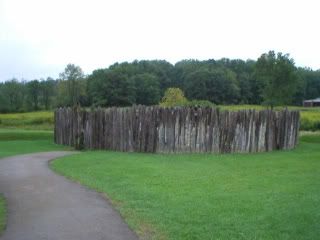
Fort McHenry from City Data
Hey, we might as well keep the fort tour going and move on to one of America's most revered forts, Baltimore's Fort McHenry.
At Fort McHenry the fledgling American forces held out against the British forces in 1814 and helped saved the new young nation after the fall of Washington during the War of 1812.
During the battle, Francis Scott Key famously wrote our National Anthem, "The Star-Spangled Banner." The banner would be hard to miss. Sewn by Mary Young Pickersgill and her daughter, it measured a whopping 40'x 32'!
And there's an eerie aside to the anthem - its melody was lifted from a British drinking song entitled "To Anacreon in Heaven." But yah, there are some real spooks roaming Fort McHenry, too.
During its existence, the fort dungeons held POWs and other assorted military neer-do-wells. National Park rangers working at the Fort report hearing bodiless footsteps, windows being opened and closed, floating furniture, unnatural auras, and doors slamming. They've allegedly seen lights turned back on after they've turned them off.
An oft-reported spook is that of a black soldier, dressed in 19th century military gear and marching back-and-forth, rifle on shoulder, on a fort footpath. His sighting lasts a few seconds before he disappears into the Maryland mists.
There have also been tales of an evil entity that haunts the inner halls of Fort McHenry.
But a couple of the Fort McHenry shadows have names and stories.
One of the apparitions that's known is that of Lieutenant Levi Claggett, who was killed, along with several of his men, by a direct hit on his post, Gun Bastion #3, during the fight. Since then, there have been numerous sightings of Claggett's ghost.
National Park rangers at the fort have reported the indistinct figure of a man walking where Claggett was killed. A photo was allegedly taken near his battery placement that shows the faint outline of a man invisible to the eye when the photo was snapped. One fort docent claimed to see a man floating above ground level.
Some spookologists surmise that Claggett's appearance is a residual haunting, kind of a never-ending movie of his fort life. He was killed so suddenly that his spirit is stuck in the eternal rut of his barrack's routine.
One other ghostie is identified by name.
Private John Drew, a 28 year-old trooper, was on guard duty, but the next morning, when his relief arrived, he was sound asleep. Drew was taken straight to the guard-house, but along the way he managed to slip a rifle he found leaning against the wall into his cell. Later, he stuck the muzzle into his mouth and pulled the trigger.
He may have thought that he was going to be shot for dereliction of duty anyway and decided to save the Army the trouble. Some speculate that because Drew shirked his responsibility in life, he has been condemned to stand eternal guard duty at Fort McHenry.
It's been said that people have seen the shadowy figure of Drew along the fort parapets, keeping an eagle eye on the fort as he should have done 125 years before.
Fort McHenry has been featured on the TV show "Haunted History," has its own Ghost Tour, and is in just about every book written about paranormal Baltimore. So if you like your history haunted...



